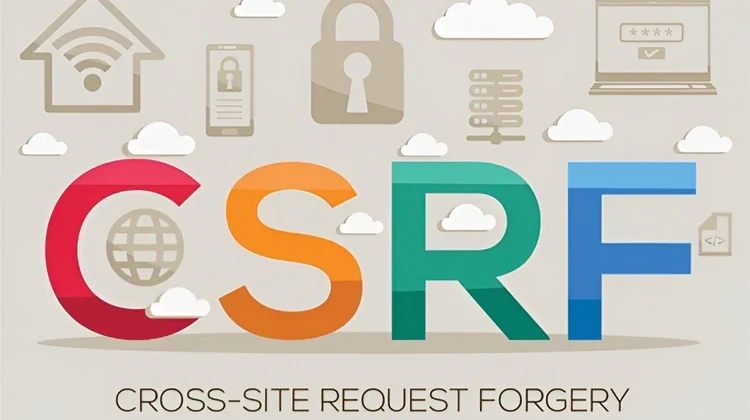
Cross-Site Request Forgery (CSRF) Protection: Shielding Your Web Application from Hidden Threats.
The digital age thrives on convenience. We bank online, manage finances, and store sensitive data–all with a few clicks and a login. But lurking beneath this convenience lies a vulnerability: Cross-Site Request Forgery (CSRF). This blog post delves deep into CSRF attacks, their deceptive nature, and, most importantly, how to carry out robust CSRF Protection for your web application.
Understanding CSRF: A Web Security Threat in Disguise
Imagine a scenario where you’re logged into your social media account, scrolling through your feed. A notification pops up with a hilarious meme. You click the link to share it with your friends, unaware that this innocent action has just triggered an unauthorized action on your account–perhaps a change of your password or a malicious post. This is a CSRF attack.
A CSRF attack exploits a web application’s trust in a logged-in user. The attacker tricks the user’s browser into submitting a forged ask to a vulnerable application. Since the user’s browser already possesses valid session cookies or credentials, the application processes the question as legitimate, leading to unintended actions.
Here’s a breakdown of the mechanics:
- The Setup: An attacker creates a malicious website, email, or social media post containing a link or form that targets a vulnerable web application.
- The Deception: The attacker entices the user to interact with the malicious content. This could be through social engineering tactics like a captivating headline or a sense of urgency.
- The Forged Ask: When the user clicks the link or submits the form, their browser includes their session cookies or credentials in the ask. This authenticates the question on the user’s behalf, even though they were unaware of the action.
- The Unintended Action: The vulnerable web application receives the forged ask and, because of existing valid credentials, processes it as legitimate. This can lead to unauthorized actions like:
- Transferring funds
- Changing account details
- Posting sensitive information
- Stealing data
The Impact of CSRF Attacks: Why Protection Matters
CSRF attacks pose a significant threat to both users and web application owners. Here’s why CSRF Protection is crucial:
- Compromised User Accounts: A successful CSRF attack can lead to unauthorized access to a user’s account. Attackers can steal sensitive data, make fraudulent transactions, or damage users’ reputations.
- Data Breaches: CSRF attacks can steal sensitive data stored within a web application. This could be personal information, financial data, or intellectual property.
- Loss of User Trust: If users know their accounts are vulnerable to CSRF attacks, they may lose trust in the web application and choose not to use it.
- Reputational Damage: A successful CSRF attack can damage a web application and the organization behind it.
Securing Your Web Application: Effective CSRF Protection Techniques
Thankfully, there are effective strategies to combat CSRF attacks and safeguard your web application. Here are the core CSRF protection methods:
- CSRF Tokens: These are secret, unpredictable values embedded within web forms or sent via HTTP headers. When a user interacts with a form, the CSRF token is generated and included with the request. The server validates the presence and validity of the token before processing any request that could modify application data. If the token is missing, invalid, or expired, the request is rejected, preventing a potential CSRF attack.
- Double Submit Cookies: Similar to CSRF tokens, these cookies contain a secret value that needs to be submitted along with the form data. This adds an extra layer of validation to ensure the request originates from your application and not a malicious source. The server verifies that the value submitted in the form matches the value stored in the cookie.
- SameSite Attribute: This HTTP attribute allows you to restrict how cookies are sent in cross-site requests. By setting the appropriate SameSite attribute value (e.g., SameSite=Strict), you can prevent browsers from including cookies in requests originating from external websites. This significantly reduces the risk of CSRF attacks, as the attacker’s website won’t be able to leverage the user’s session cookies stored on your application’s domain.
Beyond the Basics: A Multi-Layered Approach to CSRF Protection
While CSRF tokens, double-submit cookies, and the SameSite attribute are the foundation of CSRF Protection, a comprehensive approach is recommended. Here are some additional security measures to consider:
- Secure Coding Practices: Following secure coding principles like proper input validation and output sanitization can help mitigate vulnerabilities that might be exploited in CSRF attacks. For example, validating user input helps prevent attackers from injecting malicious code that could trigger CSRF attacks.
- HTTPS Enforcement: Enforcing HTTPS (Hypertext Transfer Protocol Secure) across your entire web application adds another layer of security. HTTPS encrypts communication between the user’s browser and the web server, making it significantly more difficult for attackers to intercept and manipulate requests.
- Content Security Policy (CSP): A CSP is a security directive that instructs a browser to only load resources (scripts, stylesheets, images, etc.) from authorized sources. This can help mitigate CSRF attacks by preventing the loading of malicious scripts from external websites that could be used to forge requests.
- Regular Security Testing: Proactive security testing is essential for identifying and addressing vulnerabilities before they can be exploited by attackers. Penetration testing, specifically focused on CSRF vulnerabilities, can help identify weaknesses in your application’s CSRF Protection mechanisms.
- Staying Updated: The web security landscape is constantly evolving. New CSRF attack vectors and techniques may emerge. Staying updated on the latest threats and best practices is crucial for maintaining robust CSRF Protection. Resources like security blogs, industry publications, and vulnerability databases can be valuable sources of information.
Building a Culture of Security Awareness
While technical measures are essential, a strong security posture goes beyond technology. Here’s how to cultivate a culture of security awareness within your organization:
- Security Training: Educate developers and other personnel involved in web application development about CSRF attacks and the importance of CSRF Protection.
- Secure Coding Practices: Integrate secure coding practices into your development lifecycle. This includes using secure coding libraries and frameworks and employing code review processes to identify and address potential vulnerabilities.
- Incident Response Planning: Develop a plan for how to respond to a potential CSRF attack. This plan should include steps for identifying the attack, mitigating the damage, and preventing future occurrences.
Conclusion: Keeping Your Web Application Safe from CSRF Attacks
CSRF attacks pose a significant threat to web applications, but by implementing a multi-layered approach to CSRF Protection, you can significantly reduce the risk. By combining technical security measures with secure coding practices, security awareness training, and a commitment to staying updated on the latest threats, you can create a secure environment for your users and your data.
Just to remind you, security is an ongoing process. By being proactive and vigilant, you can ensure your web application remains a fortress against CSRF attacks and other web security threats.





